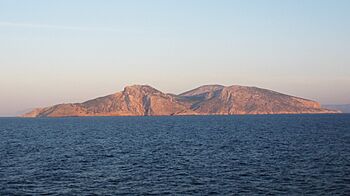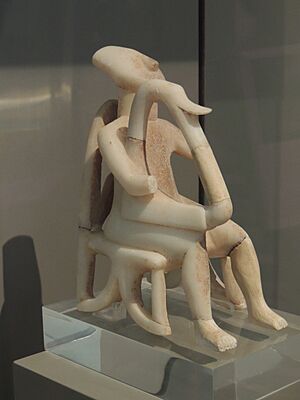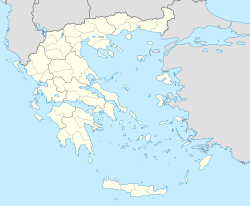Keros facts for kids
|
Native name:
Κέρος
|
|
|---|---|

Keros island, view from the north
|
|
| Geography | |
| Coordinates | 36°53′N 25°39′E / 36.89°N 25.65°E |
| Archipelago | Cyclades |
| Area | 15 km2 (5.8 sq mi) |
| Highest elevation | 432 m (1,417 ft) |
| Highest point | Mt. Keros |
| Administration | |
|
Greece
|
|
| Region | South Aegean |
| Regional unit | Naxos |
| Demographics | |
| Population | 0 (2001) |
| Additional information | |
| Postal code | 843 00 |
| Area code(s) | 22870 |
| Vehicle registration | EM |
Keros (Greek: Κέρος) is a Greek island in the Cyclades. It is about 10 kilometers (6 miles) southeast of Naxos. No one lives on Keros today.
The island is part of the Koufonisia community. Keros covers an area of 15 square kilometers (5.8 square miles). Its highest point is 432 meters (1,417 feet) tall.
Keros was a very important place for the Cycladic civilization. This ancient culture thrived around 2500 BC. Today, it is not allowed to land on Keros.
The island is famous for its unique Cycladic marble statues. These statues have flat faces. They later inspired famous artists like Pablo Picasso and Henry Moore.
The Keros Hoard
The "Keros Hoard" is a large collection of ancient Cycladic figurines. These special statues were found on Keros island. They are made of marble.
From 2006 to 2008, a team called the Cambridge Keros Project worked on the island. Colin Renfrew helped lead these excavations. They dug at a place called Kavos on the west coast.
Archaeologists believe this area is where the "Keros Hoard" came from. The objects found were mostly broken. They were likely broken somewhere else. Then, they were brought to Kavos to be placed there.
The broken pieces did not fit together. This shows that only parts of the broken items were left there. Studies also suggest the materials came from many different places.
Discoveries at Daskalio

In 2007 and 2008, the same project explored a nearby island called Daskalio. They found a large settlement from the Cycladic period. This settlement was very important.
They uncovered a big building, 16 meters (52 feet) long and 4 meters (13 feet) wide. It was the largest building from this time in the Cyclades. Inside, they found the 'Daskalio hoard'. This hoard included tools made of copper or bronze.
The team also surveyed the whole islet. They found that most of its surface, about 7,000 square meters (75,000 square feet), was used during the Early Bronze Age. This makes Daskalio the largest ancient site in the Cyclades.
Scientists studied the island's rocks, soil, and ancient plants and animals. They learned a lot about how people lived there.
In 2012, experts dated the activities at Daskalio. They happened between 2750 and 2300 BC. This was even before people started worshipping gods in the Aegean Sea area.
In 2018, more digging revealed amazing structures on Daskalio. They found huge terraced walls and shiny buildings. These were built using 1,000 tons of stone. The headland, which is only 150 meters (500 feet) across, was turned into a giant 'step pyramid' shape.
Researchers also found complex drainage tunnels. They saw signs of advanced metalworking. These discoveries make Daskalio one of the most impressive ancient sites in the Aegean Sea. It shows how skilled people were during the Early Bronze Age.
Daskalio was once connected to Keros. But now it is a tiny islet because sea level rise has separated them. Archaeologists believe ancient Greeks made at least 3,500 sea trips. They moved 7,000 to 10,000 tons of white marble between islands. This was to build the 'pyramid'-like structures.
Scientists explained that the island naturally looks like a pyramid. However, it is not a true pyramid. A real pyramid is built completely by people.
Keros-Syros Culture
The Keros-Syros culture is named after two islands: Keros and Syros. This culture was very important during the Early Cycladic II period. This was from about 2700 to 2300 BC.
Some of the best preserved sites from this culture are on Kea and Ios. These islands are close to Keros.
One special type of artifact from this culture is called a "frying pan." These are shallow, round vessels or bowls. They have decorated bases. During this time, people also started using metal much more often.
See also
- Daskalio



